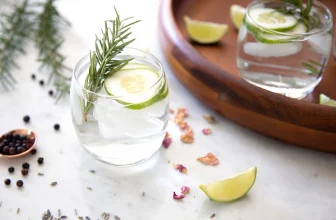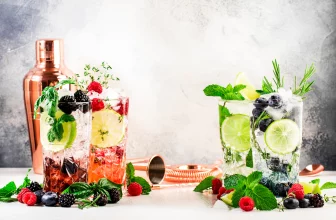You’ve no doubt heard of Rye, even if it was only in the lyrics to “American Pie.” You know … “the good old boys were drinking whiskey and rye?” But unfortunately, Don McLean was a little lax on the details when he wrote that song. What exactly is rye? And how is it made?Here’s everything you should know about rye to prove yourself the booze expert at your next happy hour!

About Rye Whiskey
All bourbons, scotches, and ryes belong to the whiskey family. Whiskeys are brown spirits that start as a fermented grain mash of wheat, barley, corn, or other grain. Unlike bourbon’s sweetness or scotch’s peat flavor, rye has a characteristic peppery bite. To let that burn really shine through, sip it neat. Or you can add an ice cube or two to cut down that spice.
Rye’s flavor can change while it is being made. After aging, rye can be bottled, or it can be finished in used barrels from other liquors like bourbon, Cognac, or Armagnac for additional flavor. But if it’s called “straight” rye, it can’t have any added flavors or colorings — just good old classic rye. Fun Fact: Whiskey in Canada is usually called Rye.
Frequently Asked Questions
How do you make Mash?
To make the mash, the grain is mixed with water and it’s all cooked down, converting the grain’s starches to sugar. Then yeast is added, which starts to eat up all that tasty sugar and turn it into alcohol. This process is called fermentation, and it can last from days to weeks.
How do you make Rye?
First you make and ferment mash. After fermentation, they pump this boozy concoction (mash) into a still. Distillation separates the rye from the unwanted flavors, keeping only the best portion of the spirit. After distillation, the rye’s alcohol content must be tested. By law, it can’t be any higher than 160 proof, or 80% alcohol by volume (ABV).
From here, the rye gets diluted with freshwater down to a max of 125 proof, or 62.5% ABV. Then it’s pumped into charred oak barrels to age. If it’s called “straight” rye, it has to be aged for at least two years.
What makes Rye different from other Whiskeys?
So if ryes, scotches, and bourbons are all whiskeys, what makes them different from each other?
There are lots of rules governing the way rye is made. The first is all about that mash. A scotch mash is made mostly of malted barley. The mash for bourbon must be at least 51% corn.
And the mash for rye must be at least 51% rye. The rest of the mash can be made of corn, wheat, malted barley, or other grains. It’s up to the distiller.
What Cocktails are made with Rye?
Rye is also a core ingredient in some of the most famous classic cocktails.
- Old Fashioned
- Sazeracs
- Manhattans
- Highball
- Summer Rye
- Vieux Carré
Rye Whiskey Pairings
Music
Food
Cannabis Strains
Where Rye Originates
History of Rye Whiskey
Unlike most other spirits, rye is truly an American liquor. In fact, rye production in America predates the country itself. Scottish and Irish immigrants built their own stills back in the 1700s, but the barley they’d used for whiskey back in their home countries didn’t grow well here. Soon they found that rye thrived and made an affordable, abundant substitute.
Pre-Revolution, rum was the drink of choice in the American colonies. But since rum comes from sugar, and the sugar-rich Caribbean islands were still under British rule after the war, rum was no longer easy to come by.
Instead, the newly minted Americans went gaga for rye. Fun fact: George Washington had a distillery at Mount Vernon with five copper pot stills where he produced 11,000 gallons of rye in 1799!
Rye was the base for some of the most popular cocktails of the 1800s, like the Sazerac and the old-fashioned. Among the drinkers of the 19th century, rye was king.
But in 1920, the party ended with the passage of the 18th Amendment — Prohibition. The rye trade — and in fact, every legal liquor trade — collapsed. But as we all know, just because something is illegal doesn’t mean it’s impossible to get. Canadian ryes were smuggled across the border, giving Americans access to our northern neighbors’ less peppery versions of the spirit.
To compound the problems for rye, major corn subsidies during the First and Second World Wars created an abundance of corn. And all that corn needed to be used for something! That something was bourbon made from corn mash.
Between the Canadian rye and American bourbon, drinkers lost their taste for the signature bite of rye. And that’s how things stood for nearly 80 years.
Fortunately, the past decade has seen a resurgence in the popularity of the classic cocktail and this spicy spirit. These days, you can get a Sazerac or a rye Manhattan at cocktail bars across the country. The rye market is reported to have grown 600% between 2009 and 2015!
Summary
Rye is a type of whiskey made from at least 51% rye grain mash. With its signature bite, rye is not a spirit for the faint of heart. But if you like bourbon or scotch, you should definitely experiment with rye.
Try it on its own, or substitute it for other brown liquors in your favorite cocktails. We’re experiencing a Ryenessaince (rye-renaissance, get it?), and you don’t want to miss it!






